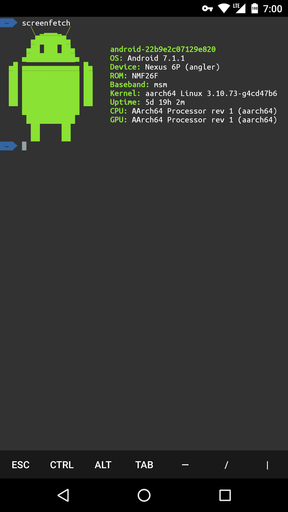A fork from oh-my-termux 。让你的 Termux 变的五颜六色~
为 Termux 添加 oh-my-zsh 终端环境,设置色彩样式(大部分来自 Gogh )和 Powerline 字体(来自 powerline/fonts)。oh-my-zsh 主题默认为 agnoster,颜色样式默认为 Tango,字体默认为 Ubuntu。
此 Repo 使用 Termux 官方源,在**大陆可能需要将 Termux 应用添加到代理列表。
sh -c "$(curl -fsSL https://github.com/Cabbagec/termux-ohmyzsh/raw/master/install.sh)"运行chcolor更换色彩样式,或者:
~/.termux/colors.sh运行chfont更换字体,或者:
~/.termux/fonts.sh- curl
-
在 home 目录下可找到按日期命名的 zshrc 备份文件,形如
.zshrc.bak.2018.1.1-00:00:00,将其文件名恢复为.zshrc。若不存在备份文件,删除当前的.zshrc。 -
在 home 目录下可找到按日期命名的 termux 备份配置目录,形如
.termux.bak.2018.1.1-00:00:00,将其文件名恢复为.termux。若不存在备份,删除当前的.termux目录。 -
重启 termux
要调整字体大小,双指缩放即可。另外,Termux 使用音量键模拟一些 shell 功能:
音量减+C:即Ctrl+C,SIGINT 中断 shell 当前进程音量减+D:即Ctrl+D,EOF 登出当前 shell音量减+E:即Ctrl+E,移动 shell 光标至行尾音量减+L:即Ctrl+L,清除屏幕内容音量减+Z:即Ctrl+Z,SIGTSTP 暂停 shell 中当前进程
其他一些按键可以使用 音量加+Q 调出快捷小键盘,也可使用下列组合:
音量加+W,音量加+A,音量加+S,音量加+D:移动光标上下左右音量加+E:ESC音量加+T:TAB音量加+数字:F1-F9,F10 使用数字 0音量加+L:管道符 “|”音量加+H:波浪符 “~"音量加+U:下划线 “_”音量加+V:控制音量
如需更好的打字输入支持,在 音量加+Q 的小键盘上向左滑动即可
Tango 颜色主题 + oh-my-zsh agnoster 主题 + Ubuntu 字体:
A fork from oh-my-termux. It makes the app more colorful.
Termux-ohmyzsh implements oh-my-zsh on your Termux app, as well as some color schemes (most are from Gogh), and some Powerline fonts (ported from powerline/fonts). Default set is agnoster for oh-my-zsh, Tango for color scheme, and Ubuntu font.
This repo requires Termux official repo. In mainland China, you may need to add Termux app to your proxy list in order to gain access to Termux official repository.
sh -c "$(curl -fsSL https://github.com/Cabbagec/termux-ohmyzsh/raw/master/install.sh)"Run chcolor to change color scheme, or run:
~/.termux/colors.shRun chfont to change font, or run:
~/.termux/fonts.sh- curl
-
Under the home directory, you can find some zshrc backup files named with date, like
.zshrc.bak.2018.1.1-00:00:00. Rename the backup file back to.zshrc. If there doesn't exist any backups, remove the current.zshrc. -
You can also find some termux configuration backup directory, named with date, like
.termux.bak.2018.1.1-00:00:00. Rename the backup directory back to.termux. If there doesn't exist any backups, remove the current.termux. -
Restart termux
Use two-finger pinch to adjust font size. Termux use combination with volume keys to emulate some functions in shell:
VolDown+C:Ctrl+C, send SIGINT to interrupt current processVolDown+D:Ctrl+D, EOF logout current sessionVolDown+E:Ctrl+E, move cursor to end of line in shellVolDown+L:Ctrl+L, clear terminal screenVolDown+Z:Ctrl+Z, send SIGTSTP to suspend current process
You can VolUp+Q to bring up an extra key bar, but you can also use combinations below:
VolUp+W/A/S/D: Move cursor up/left/down/rightVolUp+E: ESCVolUp+T: TABVolUp+Digits: F1-F9, F10 is 0VolUp+L: pipe character "|"VolUp+H: tilt character "~"VolUp+U: underscore "_"VolUp+V: Volume control
For better text input experience, swipe left on the VolUp+Q key bar.
Tango color scheme + agnoster oh-my-zsh theme + Ubuntu font:
